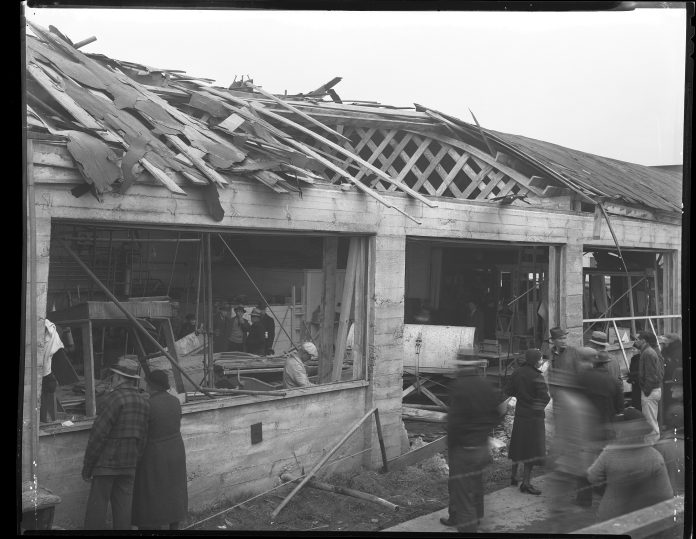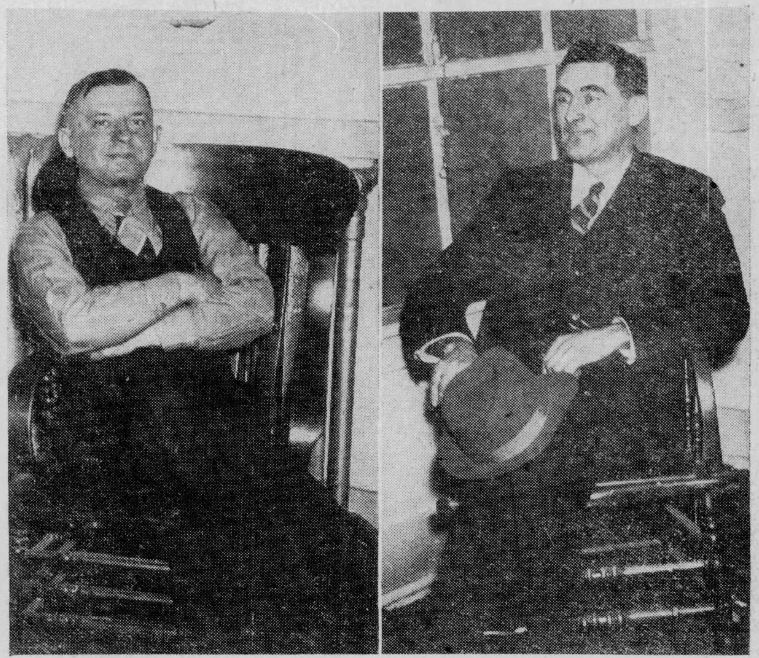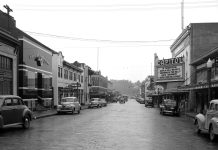
In the early morning hours of February 20, 1936, downtown Olympia was rocked by a series of explosions. The Olympia Milk Producers’ Association plant was damaged and the Sanitary Dairy was destroyed. The perpetrators were never caught.
Olympia’s Sanitary Dairy
The Sanitary Dairy opened at 314 East Fourth Avenue on June 4, 1923. Its president was Marcel Levesque (1888-1976). He was born in Wisconsin to French Canadian immigrants. Serving in the AEF during World War I, France awarded Levesque the Croix de Guerre for bravery. He came to Washington after the war.
The Dairy sold pasteurized milk, cream, cottage cheese, butter, eggs and Blue Ribbon ice cream out of their store and by delivery. Everything was sanitary, they promised. It was in the name after all.
The store soon relocated to 310 East Fourth. With long daily hours, the Sanitary Dairy was also praised by shoppers for its stock of groceries, including crackers, cheese, canned goods and soda.
Turbulent Times for Sanitary Dairy in Olympia History
Their building was demolished to build the Avalon Theater and in January 1928, the Dairy reopened at their old location at 314 East Fourth. The building was owned by Joseph Patrico (1889-1975), a Hungarian immigrant and veteran who operated a tailor shop inside. A separate unit of apartments was in the back.
In December 1929, a fire gutted Patrico’s tailor shop and destroyed the Dairy’s office. Insurance covered losses.
The Dairy was hit hard by the Great Depression. They switched to cash and carry only, and began distributing Meadowsweet Dairies Inc. of Pierce County’s instant-frozen ice cream. It was frozen in 15 seconds rather than several hours like their own had been.
The Sanitary Dairy began buying much of its milk from the Olympia Milk Producers’ Association. This farmers’ co-operative began in 1932 with over 100 local farmers. The group hoped to stabilize – and control – milk prices in the faltering economy. They opened a plant at 511 Cherry Street in 1932.
Then disaster struck.

Olympia Bombings
On February 20, 1936, at 1:10 a.m. an explosion ripped through the Association’s plant.
At 1:25 a.m. a minor explosion went off at the Sanitary Dairy. Rushing from an adjacent hotel, longshoreman Frank Andrews warned the apartment residents to flee. Two bakers from the nearby Daylight Bakery crossed the street to have a look.
As the bakers were returning to the bakery at 1:29 a.m., a second larger explosion went off. The residents and Andrews were knocked off their feet. Andrews was hit by flying glass. The frame building was entirely wrecked. The explosion was felt throughout the city, breaking about 450 panes of glass at the Olympia Knitting Mills across the alley.
These explosions had been no accident, investigators determined quickly. Dynamite had been dropped through a broken window at the Association’s plant and stuffed into milk cans at the Dairy. The first explosion at the Dairy, they guessed, might have been a warning to give residents time to flee.
Investigating Olympia’s Dairy Bombings
Tips poured into police. Ten minutes before the Association’s plant exploded, a cooperative driver had delivered milk to the plant. A tall man in a dark overcoat and blue hat had been seen nearby. Someone reported that a powerboat had stopped in the harbor around the time of the explosion.Levesque and Patrico offered a $100 reward for information.
The work, police suspected, was likely local but by someone who knew dynamite. There was no “milk war” going on between producers but perhaps it could be a disgruntled dairy farmer.
As investigators worked, Levesque salvaged bottles and cans from the wreckage and started bottling at the Meadowlark Dairy. Although their building was not destroyed, the Association reopened at 209 West State Avenue on May 1. Total losses from the explosions were estimated at $40,000.
Levesque and Patrico had riot, explosion, and civil disturbance insurance, taken out after the Hunger March of 1932.

Leads in Olympia Dairy Bombing Weak
Three years to the day after the bombing, Levesque and Patrico were arrested. Prosecutors charged the co-defendants on two counts of endangering life and property with explosives, one for each building. A third person, “John Doe” Larkin, was also charged but could not be tracked down. Prosecutors believed he was not from Olympia. If convicted, the co-defendants faced a maximum sentence of 20 years in prison.
The two posted bail. They demanded a grand jury review their case. That December, after listening to witnesses, the grand jury recommended that they be prosecuted, despite weak evidence.
But the case stalled. In March, the pair petitioned the court to drop the charges on the grounds they had not been properly filed before the three-year statutory limit. It took until December for the court to do so, after two important state witnesses had died.
“The evidence was only strongly circumstantial,” Prosecutor John Lynch Jr. told the press, urging the community to give the defendants the benefit of the doubt.
After the Sanitary Dairy Bombing
Levesque and Patrico remained in town. Levesque became a custodian and worked for Miller Department Store. He and his wife Hattie received the Washington State Distinguished Citizen Award in 1969.
Patrico continued as a tailor, rebuilding his shop at 314 East Fourth. He acted as translator for refugees from the Hungarian Revolution of 1956. A bit of a recluse in his later years, he donated the 312-314 Fourth Avenue Building to the city in his will. As he wished, proceeds from its sale went to the Senior Center.
So if Levesque and Patrico were innocent, who bombed the Sanitary Dairy and Milk Producers Association Building? Someone knew. But perhaps, after all this time, no one else ever will.



















































